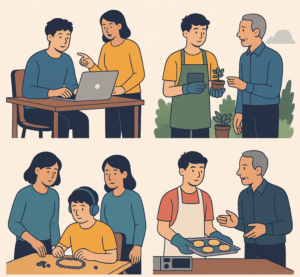Vocational Training in Autism: Building Skills, Fostering Independence
 Autism is a lifelong neurodevelopmental condition, but that doesn’t mean it limits a person’s potential. With the right support, many autistic individuals can thrive in the workplace—particularly when vocational training is introduced early, respectfully, and with an individualized approach.
Autism is a lifelong neurodevelopmental condition, but that doesn’t mean it limits a person’s potential. With the right support, many autistic individuals can thrive in the workplace—particularly when vocational training is introduced early, respectfully, and with an individualized approach.
In my work with adolescents and young adults on the spectrum, vocational training often becomes a turning point. It helps them move from dependence to dignity.
🧩 Why Is Vocational Training Important in Autism?
Many autistic individuals:
-
Struggle with mainstream academics
-
Have strengths in routines, attention to detail, visual learning, or technology
-
Face difficulties in executive function, communication, and sensory regulation
-
May be underestimated due to stereotypes
Vocational training:
-
Builds employable skills
-
Encourages social interaction
-
Improves self-esteem
-
Reduces caregiver burden
-
Promotes community inclusion
🧠 When to Start?
Age 14–16 is ideal to begin vocational exploration. For some, even earlier with life skills training (cooking, handling money, using public transport) in middle school can lay the foundation.
🔧 Areas of Vocational Training
-
Computer-based Work: Data entry, graphic design, coding, digital art
-
Hospitality: Housekeeping, laundry, pantry work in cafes/hotels
-
Gardening & Agriculture: Nursery maintenance, hydroponics, farm work
-
Crafts & Assembly: Envelope making, jewelry design, packaging
-
Retail: Inventory management, labeling, billing with visual tools
-
Kitchen Skills: Bakery items, snacks, catering services
-
Office Support: Lamination, printing, filing, scanning
-
Entrepreneurship: Home-based candle or soap making, t-shirt design
Training must be interest-based, not imposed. Strengths-first, not deficit-focused.
👥 Role of Professionals
-
Occupational therapists: Develop task sequencing and motor skills
-
Special educators: Build cognitive and academic prerequisites
-
Speech therapists: Improve communication in work settings
-
Psychiatrists & psychologists: Manage coexisting issues like anxiety, OCD, ADHD
-
Vocational trainers: Bridge gap between school and real-world work
As a psychiatrist, I often collaborate with families to customize Individualized Transition Plans (ITPs) based on functional levels and goals.
🏢 Supported Employment vs. Open Employment
-
Supported employment involves on-site job coaches and disability-friendly settings.
-
Open employment means competing in regular work environments.
Both are valid paths. The choice depends on the person’s readiness and support needs.
🌱 Family and Societal Involvement
-
Parents should be encouraged to focus on function and independence, not just academics.
-
Employers need sensitization about autism and inclusion.
-
Government and NGOs can offer certification, stipends, or skill-building platforms (e.g., NIOS, PMKVY).
💬 Success Story
Take Rohan, a 19-year-old with autism who struggled with academics but had a knack for patterns and order. Through structured training at a local NGO, he now manages inventory in a stationery warehouse—and beams with pride every payday. His parents say, “For the first time, he feels like an adult.”
Final Thoughts
Vocational training isn’t a backup plan for autistic individuals—it’s often the best plan. The goal isn’t just employment, but purpose, routine, and respect. When we focus on ability, not disability, the outcomes can be life-changing.
📍 Dr. Srinivas Rajkumar T
Consultant Psychiatrist – Child, Adolescent & Geriatric Psychiatry
Apollo Clinics Velachery & Tambaram | Mind & Memory Lab
🌐 www.srinivasaiims.com | 📞 +91 85951 55808
Specialist in neurodevelopmental assessments, early intervention, and transition planning.
Related posts:
- Couples Therapy: Strengthening Relationships and Building Lasting Connections
- Early Signs of Autism: Understanding and Managing Autism Spectrum Disorder
- 🧠 Essential DBT Skills Everyone Should Know
- Autism Across the Lifespan: From Childhood to Adulthood
- Co-Occurring Conditions in Autism
- Autism Assessment in Chennai: What Every Parent Needs to Know